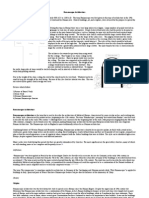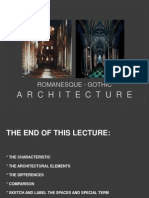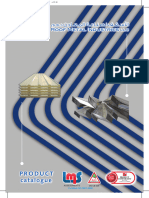Romanesque Style: Mid 12th Century and The 16th Century Masonry Building
Romanesque Style: Mid 12th Century and The 16th Century Masonry Building
Uploaded by
JaskiratCopyright:
Available Formats
Romanesque Style: Mid 12th Century and The 16th Century Masonry Building
Romanesque Style: Mid 12th Century and The 16th Century Masonry Building
Uploaded by
JaskiratOriginal Description:
Original Title
Copyright
Available Formats
Share this document
Did you find this document useful?
Is this content inappropriate?
Copyright:
Available Formats
Romanesque Style: Mid 12th Century and The 16th Century Masonry Building
Romanesque Style: Mid 12th Century and The 16th Century Masonry Building
Uploaded by
JaskiratCopyright:
Available Formats
- Romanesque architecture is divided into two - appearance of walls, piers , arches and openings, - Pisa cathedral
8. ROMANESQUE STYLE arcades , columns , vaults , and roofs and in the - Leaning tower of Pisa
periods: the “First Romanesque” style and the
“Romanesque” style. The First Romanesque materials used to create these features.
style developed in the north of Italy, parts of - the pairing of two arched windows or arcade - Canterbury cathedral
France, and the Iberian Peninsula in the openings separated by a pillar or colonette and The cathedral is one of the
10th century prior to the later influence of often set within a larger arch. oldest and most famous
the Abbey of Cluny. - Columns were often used in Romanesque Christian structures of
Vaults of Canterbury
architecture, but varied in building material and Romanesque Architecture
cathedral
- Romanesque architecture was the first decorative style. located in Canterbury, Kent,
distinctive style to spread across Europe - wooden roofs consisting of a simple truss , tie England. Norman is the term
since the Roman Empire. beam, or king post form used to describe Romanesque in Leaning tower of
- Started from about the mid-11th century England. Pisa
- Gothic Architecture is a pan-European style - It is usually characterized as a style of masonry Notre-Dame de Reims, France
9. GOTHIC STYLE that lasted between the mid 12th Century and building that makes heavy use of cavernous spaces The kings of France were
the 16th Century. with walls broken up by overlaid tracery. crowned in this cathedral,
constructed during the 13th
- Typical architectural features include: century on the site of an old Notre-Dame de
1. Rib vaults church dating from the year Reims, France
2. Flying buttresses 400
3. Pointed Gothic arches Basilica of Saint Denis, France
4. Stained glass windows were also common Noted as the first Gothic
cathedral (it was completed in
1144), this church holds the Basilica of
graves for all but three of the Saint Denis,
French monarchs France
- The renaissance period lies between 1400 to - Renaissance architects also incorporated columns St Peter’s Basilica
10. RENAISSANCE STYLE 1600. and pilasters, using the Roman orders of columns Designed by Alberti, Raphael,
- A return to Classical ideas ushered an "age (Tuscan, Doric, Ionic, Corinthian, and Composite) as Bramante, Michelangelo, and
of awakening" in Italy, France, and England. models. Bernini, St Peter’s Basilica was
- During the Renaissance era architects and - External Renaissance walls were generally of perhaps the most renowned
builders were inspired by the carefully highly finished ashlar masonry, laid in straight work of Renaissance
proportioned buildings of ancient Greece courses . architecture. St peter’s
and Rome. - The corners of buildings were often emphasized by basilica
- The three key Renaissance architects were rusticated quoins. Tempietto del Bramante
Filippo Brunelleschi, Leon Battista Alberti, - The Renaissance style eschewed the complex The tiny, round temple by
and Andrea Palladio. proportional systems and irregular profiles of Donato Bramante sits inside the
- As in the Classical world, Renaissance Gothic structures, and placed emphasis on courtyard of the church of San
architecture was characterised by the symmetry , proportion, geometry, and regularity of Pietro in Montorio in Rome, on
harmony between human and mathematical parts. the spot where St Peter was
proportions - Key architectural elements of Renaissance crucified
buildings included columns, pilasters, pediments, Tempietto del
entablatures, arches, and domes. Bramante
- The architecture of the United States - art nouveau - Dynamic, undulating, and flowing, Empire State Building – art deco
11. ARCHITECTURE IN U.S Empire state building
demonstrates a broad variety of with curved 'whiplash' lines which characterized Chrysler Building – art deco
architectural styles and built forms over much of Art Nouveau movement. Taliesin – prairie school
Chrysler building
the country's history of over two centuries
of independence and former Spanish and - contemporary architecture - Exposed functional
British rule building elements, such as ground-to-ceiling plate
glass windows, and smooth facades. - The style Taliesin
- COLONIAL ARCHITECTURE was molded from modern materials--concrete,
- ROMANTIC ARCHITECTURE glass, and steel.
- VICTORIAN ARCHITECTURE
- ART NOUVEAU
- CONTEMPORARY ARCHITECTURE - prairie style architecture - Boxy and symmetrical
- PRAIRIE STYLE ARCHITECTURE or low slung and asymmetrical. - Roofs are low-
- ART DECO STYLE
pitched, with wide eaves.
-
You might also like
- Basement SeminarDocument22 pagesBasement SeminarJaskiratNo ratings yet
- Facade ConstructionDocument16 pagesFacade ConstructionJaskirat100% (1)
- Italy Architectural History PresentationDocument20 pagesItaly Architectural History PresentationLujain MtawaNo ratings yet
- Key Points:: RomanesqueDocument78 pagesKey Points:: Romanesqueeiro abainzaNo ratings yet
- History 2Document38 pagesHistory 2Day-an BumanglagNo ratings yet
- ARTID121 - Romanesque ArtDocument101 pagesARTID121 - Romanesque ArtarkioskNo ratings yet
- Pangasinan State University: Hoa 212 - History of Architecture 2Document14 pagesPangasinan State University: Hoa 212 - History of Architecture 2Chanty LenchicoNo ratings yet
- Ilovepdf MergedDocument222 pagesIlovepdf MergedAyush patilNo ratings yet
- Romanesque ArchitectureDocument13 pagesRomanesque ArchitectureSAURABH KUMAR SINGH100% (1)
- History of Gothic ArchitectureDocument5 pagesHistory of Gothic ArchitectureTherese SarmientoNo ratings yet
- 14 Renaissance To Neo Classical PDFDocument29 pages14 Renaissance To Neo Classical PDFSakshamZSharmaNo ratings yet
- Romanesque ArchitectureDocument13 pagesRomanesque ArchitectureSam_Dichoso_4540100% (2)
- Brief History of Romanesque ArchitectureDocument31 pagesBrief History of Romanesque ArchitectureHomer CamposagradoNo ratings yet
- Romanesque Architecture WWW - SamueldichosoDocument13 pagesRomanesque Architecture WWW - SamueldichosoSam_Dichoso_4540No ratings yet
- Romanesque Art: Caen, FranceDocument40 pagesRomanesque Art: Caen, FrancePrateek SrivastavaNo ratings yet
- HoA Presentation - RomanesqueDocument19 pagesHoA Presentation - RomanesqueTsegab DereseNo ratings yet
- History of Architecture - V R01-CompressedDocument158 pagesHistory of Architecture - V R01-CompressedAyush patilNo ratings yet
- Romanesque Architecture - LectureDocument66 pagesRomanesque Architecture - Lecturekritikas.ug20.arNo ratings yet
- Hoa Sakit UloDocument66 pagesHoa Sakit UloabottabottabottNo ratings yet
- Norman CathedralsDocument11 pagesNorman CathedralsAndrei IliescuNo ratings yet
- Romanesque ArchitectureDocument31 pagesRomanesque ArchitectureHomer Camposagrado100% (1)
- Research Work IN Arcompre: Department of Engineering and Architecture College of ArchitectureDocument40 pagesResearch Work IN Arcompre: Department of Engineering and Architecture College of Architectureboddie medallaNo ratings yet
- Architecture of London Preparatory MaterialsDocument22 pagesArchitecture of London Preparatory MaterialsMaximo Cusihuata ChoqueNo ratings yet
- Handout 2Document10 pagesHandout 2Joud AldurraNo ratings yet
- History of Architecture Reviewer P2Document50 pagesHistory of Architecture Reviewer P2vanessajuansingNo ratings yet
- Gervacio Gilliane HoaDocument4 pagesGervacio Gilliane HoaZillah Paz RuperezNo ratings yet
- Romanesque ArchDocument100 pagesRomanesque ArchChitra SrivastavaNo ratings yet
- Unit IV Romanesque ArchitectureDocument28 pagesUnit IV Romanesque ArchitecturePrachi PandeNo ratings yet
- Gothic Architecture 2Document37 pagesGothic Architecture 2Sandesh PuppalNo ratings yet
- Romanesque Early Christian GothicDocument5 pagesRomanesque Early Christian GothicNopeNotNiceNo ratings yet
- Renaissance ReviewerDocument7 pagesRenaissance ReviewerKhey casinginanNo ratings yet
- Hoa 2 Romanesque Quiz ReviewerDocument9 pagesHoa 2 Romanesque Quiz ReviewerBrianAngeloAlmazanArocenaNo ratings yet
- 01 - Romanesque - History 102 - TimelineDocument5 pages01 - Romanesque - History 102 - TimelineRon S BaiNo ratings yet
- HOA2 - Gothic Arch2Document6 pagesHOA2 - Gothic Arch2Diego AlmeidaNo ratings yet
- BrochurerealDocument2 pagesBrochurerealapi-366842733No ratings yet
- Renaissance Architecture: Hoa V Sir MvsaDocument24 pagesRenaissance Architecture: Hoa V Sir Mvsarevathi hariharanNo ratings yet
- UntitledDocument53 pagesUntitledmntyhhNo ratings yet
- Romanesque Architecture: Formation and DevelopmentDocument4 pagesRomanesque Architecture: Formation and DevelopmentMooni Broke0% (1)
- Ornementation:: Other Examples of Gothic ArchesDocument2 pagesOrnementation:: Other Examples of Gothic ArchesKelly Camille AlairNo ratings yet
- Medieval Gothic at RomanesqueDocument27 pagesMedieval Gothic at RomanesqueAaron BongonNo ratings yet
- Romanesque in European Countries - Final ReportDocument49 pagesRomanesque in European Countries - Final ReportarchitectjeyNo ratings yet
- ARH1000 RomanesqueGothicDocument6 pagesARH1000 RomanesqueGothicKritika RoyNo ratings yet
- Hoa ScriptDocument9 pagesHoa ScriptPatrick LeandadoNo ratings yet
- Hoa 2 Romanesque Quiz ReviewerDocument10 pagesHoa 2 Romanesque Quiz ReviewerSophie DatuNo ratings yet
- PramodDocument29 pagesPramodNishan RaiNo ratings yet
- Romanesque ArchitectureDocument4 pagesRomanesque ArchitectureErikaNo ratings yet
- Module 1 - Romanesque ArchitectureDocument13 pagesModule 1 - Romanesque ArchitectureJerica YuNo ratings yet
- Hoa 2Document3 pagesHoa 2Bianca EuniceNo ratings yet
- AR12-43 History of Architecture - IiiDocument40 pagesAR12-43 History of Architecture - IiishaNo ratings yet
- Romanesque Architecture FinalDocument26 pagesRomanesque Architecture Final10Radha GaikwadNo ratings yet
- Arts Appreciation Project History of ArchitectureDocument32 pagesArts Appreciation Project History of ArchitectureKristine CatariningNo ratings yet
- Amity School of Architecture and Planning: B.Arch. Sem - IIIDocument37 pagesAmity School of Architecture and Planning: B.Arch. Sem - IIInirvaangNo ratings yet
- 06 - Romanesque & GothicDocument87 pages06 - Romanesque & GothicEdmund Chui100% (3)
- Italian Renaissance1Document23 pagesItalian Renaissance1poornima lakshmiNo ratings yet
- Renaissance Architecture: Presented By: Shobhit BanerjeeDocument25 pagesRenaissance Architecture: Presented By: Shobhit BanerjeeAshutosh SinghNo ratings yet
- Na Temple StyleDocument6 pagesNa Temple StyleShannelle Anne CaballeroNo ratings yet
- Gothic Architecture: in France Notable Churches On Île-de-France RegionDocument23 pagesGothic Architecture: in France Notable Churches On Île-de-France RegionJohn Bryan EspirituNo ratings yet
- Romanesque To 21ST CenturyDocument32 pagesRomanesque To 21ST Centurydaphnee LopezNo ratings yet
- Romanesque Architecture: RevisionDocument37 pagesRomanesque Architecture: Revisiontanu kukrejaNo ratings yet
- Medieval ArchitectureDocument4 pagesMedieval ArchitectureLoraine Kytes Baliquia100% (1)
- Commercial Kitchen (Ass. 2)Document21 pagesCommercial Kitchen (Ass. 2)JaskiratNo ratings yet
- Curtain Wall (Jaskirat)Document29 pagesCurtain Wall (Jaskirat)JaskiratNo ratings yet
- Building Case StudyDocument49 pagesBuilding Case StudyJaskiratNo ratings yet
- I.K.G. P.T.U Campus Mohali-Ii: Report On Pre-FaricationDocument12 pagesI.K.G. P.T.U Campus Mohali-Ii: Report On Pre-FaricationJaskiratNo ratings yet
- Building Services PPT PlumbingDocument26 pagesBuilding Services PPT PlumbingJaskiratNo ratings yet
- Petronas Tower and Ritz TowerDocument28 pagesPetronas Tower and Ritz TowerJaskirat100% (1)
- Building Economics - IIIDocument34 pagesBuilding Economics - IIIJaskiratNo ratings yet
- Components of PrefabricationDocument18 pagesComponents of PrefabricationJaskiratNo ratings yet
- High Rise Building.-Fire Safety ServicesDocument10 pagesHigh Rise Building.-Fire Safety ServicesJaskirat100% (1)
- Comparative Economic Analysis of Low Rise High Rise BuildingDocument4 pagesComparative Economic Analysis of Low Rise High Rise BuildingJaskiratNo ratings yet
- Synopsis of Jit Sir Lecture: Housing (Assignment - V)Document4 pagesSynopsis of Jit Sir Lecture: Housing (Assignment - V)JaskiratNo ratings yet
- Building Economics - IIDocument4 pagesBuilding Economics - IIJaskiratNo ratings yet
- Question/Answer Assignment: High Rise Building (Assignment - Iii)Document36 pagesQuestion/Answer Assignment: High Rise Building (Assignment - Iii)Jaskirat100% (1)
- High Rise Building Case StudyDocument26 pagesHigh Rise Building Case StudyJaskiratNo ratings yet
- Study of Prefabricated StructuresDocument30 pagesStudy of Prefabricated StructuresJaskiratNo ratings yet
- Sustainability and Green Technologies: High Rise Building (Assignment - Iii)Document14 pagesSustainability and Green Technologies: High Rise Building (Assignment - Iii)JaskiratNo ratings yet
- Students Have To Answer at Least 6 Questions From The Set Allotted To Them Roll No. WiseDocument4 pagesStudents Have To Answer at Least 6 Questions From The Set Allotted To Them Roll No. WiseJaskiratNo ratings yet
- Housing Typologies: United Kingdom, Europe and AfricaDocument26 pagesHousing Typologies: United Kingdom, Europe and AfricaJaskiratNo ratings yet
- Basement Const. DetailsDocument7 pagesBasement Const. DetailsJaskiratNo ratings yet
- QnA ASSIGNMENTDocument26 pagesQnA ASSIGNMENTJaskiratNo ratings yet
- Housing Typologies-Us, Europe, AfricaDocument31 pagesHousing Typologies-Us, Europe, AfricaJaskiratNo ratings yet
- Housing Survey CensusDocument16 pagesHousing Survey CensusJaskiratNo ratings yet
- Analysis and Design of G+5 Mixed Use Building by New EBCS CodeDocument190 pagesAnalysis and Design of G+5 Mixed Use Building by New EBCS CodegirumNo ratings yet
- 09 19 2022 - Joey Cakderon 2 Storey Residential - PROJECT COST PROPOSALDocument5 pages09 19 2022 - Joey Cakderon 2 Storey Residential - PROJECT COST PROPOSALfrancis sebastian lagamayoNo ratings yet
- Convention Centre Desktop StudyDocument9 pagesConvention Centre Desktop Studysusri mallipudiNo ratings yet
- Roman Baths and BathingDocument6 pagesRoman Baths and Bathingguy grossmanNo ratings yet
- Chummary Quarters at KilinochchiDocument44 pagesChummary Quarters at KilinochchiMohamed Faiz Issma LebbeNo ratings yet
- Basix CertificateDocument8 pagesBasix CertificaterimshaNo ratings yet
- MinarsDocument9 pagesMinarsaseemkashyapNo ratings yet
- MahamayaDocument6 pagesMahamayaShailendra DubeyNo ratings yet
- SN BOQ - G+2 FinalDocument7 pagesSN BOQ - G+2 FinalHailuGelanHubenaNo ratings yet
- First & Second Floor Plan: Client Mr. Kamlesh YDocument1 pageFirst & Second Floor Plan: Client Mr. Kamlesh YkamleshyadavmoneyNo ratings yet
- Effekt ProfileDocument35 pagesEffekt ProfilemilanatanaskovicNo ratings yet
- Shoaib Ahmed KhanDocument3 pagesShoaib Ahmed Khanraoof ahmedNo ratings yet
- HDB - Mechanical Engineering Supervision Guide 2012Document60 pagesHDB - Mechanical Engineering Supervision Guide 2012yarzar172040100% (1)
- Your Home Interiors Quotation.: WWW - Aantrik.inDocument21 pagesYour Home Interiors Quotation.: WWW - Aantrik.inhiteshNo ratings yet
- Specification: Project Title: Proposed PenthouseDocument7 pagesSpecification: Project Title: Proposed PenthouseCamill FernandezNo ratings yet
- Southbrooke Brochure 1-6Document34 pagesSouthbrooke Brochure 1-6humblyhajaNo ratings yet
- Architectural Design LightingDocument23 pagesArchitectural Design LightingTricia Marvi P. Navarro50% (2)
- RoofMetal Catalog 2018Document38 pagesRoofMetal Catalog 2018khalid mohamedNo ratings yet
- Sharaka HoldingsDocument6 pagesSharaka HoldingsSindhu NairNo ratings yet
- Corpse Party Book of Shadows WalkthroughDocument22 pagesCorpse Party Book of Shadows WalkthroughSavas MicheliosNo ratings yet
- Revit Arch 2017 BookDocument89 pagesRevit Arch 2017 Booksr936879No ratings yet
- Philippine Architecture by JMLDocument33 pagesPhilippine Architecture by JMLMagic Mendoza100% (1)
- Part II Video Quiz 6 Central Park Jack Stauber-1Document3 pagesPart II Video Quiz 6 Central Park Jack Stauber-1jack stauberNo ratings yet
- NoxDocument4 pagesNoxMiriam AdamsNo ratings yet
- Straight Flight Staircase S: AnalyticalDocument9 pagesStraight Flight Staircase S: AnalyticalShaurya ChauhanNo ratings yet
- BOM - 20210301 - Corazon Priestley - Rev2aDocument6 pagesBOM - 20210301 - Corazon Priestley - Rev2aEphrem Marx AparicioNo ratings yet
- ODCJcomp2017 - Competition BriefDocument11 pagesODCJcomp2017 - Competition BriefAraNo ratings yet
- Aranda Breeze at Yishun Nov 2022 BTODocument26 pagesAranda Breeze at Yishun Nov 2022 BTOpriscillasooNo ratings yet
- G4 Ventilation 3rd Edition Amendment 2Document26 pagesG4 Ventilation 3rd Edition Amendment 2nguoikhoNo ratings yet
- AID in PUNEDocument16 pagesAID in PUNEShipra SinghNo ratings yet

















































































































